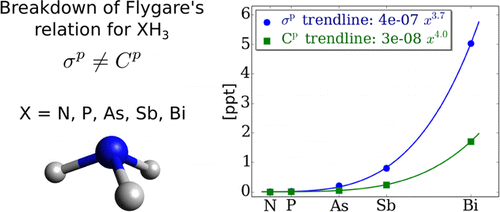当前位置:
X-MOL 学术
›
J. Chem. Theory Comput.
›
论文详情
Our official English website, www.x-mol.net, welcomes your
feedback! (Note: you will need to create a separate account there.)
Four-Component Relativistic Density-Functional Theory Calculations of Nuclear Spin–Rotation Constants: Relativistic Effects in p-Block Hydrides
Journal of Chemical Theory and Computation ( IF 5.7 ) Pub Date : 2015-07-15 00:00:00 , DOI: 10.1021/acs.jctc.5b00276 Stanislav Komorovsky 1 , Michal Repisky 1 , Elena Malkin 1 , Taye B. Demissie 1 , Kenneth Ruud 1
Journal of Chemical Theory and Computation ( IF 5.7 ) Pub Date : 2015-07-15 00:00:00 , DOI: 10.1021/acs.jctc.5b00276 Stanislav Komorovsky 1 , Michal Repisky 1 , Elena Malkin 1 , Taye B. Demissie 1 , Kenneth Ruud 1
Affiliation

|
We present an implementation of the nuclear spin–rotation (SR) constants based on the relativistic four-component Dirac–Coulomb Hamiltonian. This formalism has been implemented in the framework of the Hartree–Fock and Kohn–Sham theory, allowing assessment of both pure and hybrid exchange–correlation functionals. In the density-functional theory (DFT) implementation of the response equations, a noncollinear generalized gradient approximation (GGA) has been used. The present approach enforces a restricted kinetic balance condition for the small-component basis at the integral level, leading to very efficient calculations of the property. We apply the methodology to study relativistic effects on the spin–rotation constants by performing calculations on XHn (n = 1–4) for all elements X in the p-block of the periodic table and comparing the effects of relativity on the nuclear SR tensors to that observed for the nuclear magnetic shielding tensors. Correlation effects as described by the density-functional theory are shown to be significant for the spin–rotation constants, whereas the differences between the use of GGA and hybrid density functionals are much smaller. Our calculated relativistic spin–rotation constants at the DFT level of theory are only in fair agreement with available experimental data. It is shown that the scaling of the relativistic effects for the spin–rotation constants (varying between Z3.8 and Z4.5) is as strong as for the chemical shieldings but with a much smaller prefactor.
中文翻译:

自旋旋转常数的四分量相对论密度泛函理论计算:p嵌段氢化物的相对论效应
我们根据相对论的四分量狄拉克-库仑哈密顿量给出了核自旋旋转(SR)常数的实现。这种形式主义已在Hartree-Fock和Kohn-Sham理论的框架内实施,从而可以评估纯交换混合功能和混合交换相关功能。在响应方程的密度泛函理论(DFT)实施中,已使用非共线广义梯度逼近(GGA)。本方法对小组分基础在积分水平上施加了受限的动平衡条件,从而导致非常有效的性质计算。我们通过对XH n(n= 1–4)对元素周期表p块中的所有元素X进行比较,并将相对性对核SR张量的影响与对核磁屏蔽张量的影响进行比较。密度泛函理论所描述的相关效应对于自旋旋转常数具有显着影响,而GGA的使用与混合密度泛函之间的差异要小得多。我们在DFT理论水平上计算出的相对论自旋旋转常数仅与可用的实验数据完全吻合。结果表明,相对论效应的标度是自旋-旋转常数(在Z 3.8和Z 4.5之间变化))的强度与化学屏蔽层一样强,但前置因子要小得多。
更新日期:2015-07-15
中文翻译:

自旋旋转常数的四分量相对论密度泛函理论计算:p嵌段氢化物的相对论效应
我们根据相对论的四分量狄拉克-库仑哈密顿量给出了核自旋旋转(SR)常数的实现。这种形式主义已在Hartree-Fock和Kohn-Sham理论的框架内实施,从而可以评估纯交换混合功能和混合交换相关功能。在响应方程的密度泛函理论(DFT)实施中,已使用非共线广义梯度逼近(GGA)。本方法对小组分基础在积分水平上施加了受限的动平衡条件,从而导致非常有效的性质计算。我们通过对XH n(n= 1–4)对元素周期表p块中的所有元素X进行比较,并将相对性对核SR张量的影响与对核磁屏蔽张量的影响进行比较。密度泛函理论所描述的相关效应对于自旋旋转常数具有显着影响,而GGA的使用与混合密度泛函之间的差异要小得多。我们在DFT理论水平上计算出的相对论自旋旋转常数仅与可用的实验数据完全吻合。结果表明,相对论效应的标度是自旋-旋转常数(在Z 3.8和Z 4.5之间变化))的强度与化学屏蔽层一样强,但前置因子要小得多。















































 京公网安备 11010802027423号
京公网安备 11010802027423号